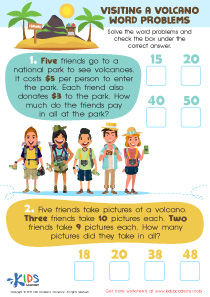Basic Arithmetic Normal Addition and Subtraction Word Problems Worksheets for Ages 4-9
4 filtered results
-
From - To
Welcome to our "Basic Arithmetic Normal Addition and Subtraction Word Problems Worksheets" designed for children ages 4-9! These engaging worksheets help young learners develop essential math skills through fun and relatable word problems. Covering basic addition and subtraction, our materials encourage critical thinking and problem-solving in an age-appropriate manner. Each worksheet presents real-life scenarios, making math more relevant and enjoyable for kids. Perfect for teachers and parents looking to supplement classroom learning or reinforce skills at home, our worksheets are printable and easy to use. Start building a strong math foundation for your child today!


Counting Spider Eyes Worksheet


Garage Sale - More yhan Worksheet


Solve the Problem: Trick–or–treating Worksheet


Supermarket Math Worksheet
Basic arithmetic, particularly normal addition and subtraction word problems, plays a pivotal role in the cognitive development of children aged 4-9. These foundational skills are essential not just for mathematics, but also for critical thinking and problem-solving abilities that children will utilize throughout their lives.
Understanding word problems fosters literacy skills, as children learn to decode language and extract meaning from context. This intertwining of literacy and numeracy secures a more holistic educational approach. Furthermore, these problems help children connect math concepts to real-world situations, enhancing their understanding of how mathematics functions in everyday life, from budgeting their allowance to measuring ingredients in a recipe.
For parents and teachers, encouraging children to engage with these problems can build confidence and a positive attitude towards math. Practical experience with addition and subtraction through relatable scenarios instills a sense of accomplishment, reinforcing persistence and resilience when faced with challenges.
Ultimately, prioritizing basic arithmetic word problems cultivates a stronger mathematical foundation, preparing students for future academic success, fostering a love of learning, and equipping them with essential life skills that extend beyond the classroom. Thus, investing attention and resources in these areas is crucial for empowering young learners.
 Assign to My Students
Assign to My Students




















